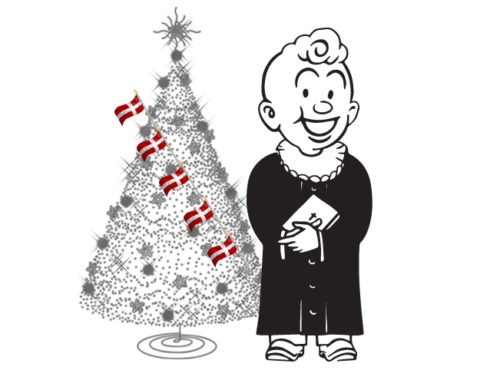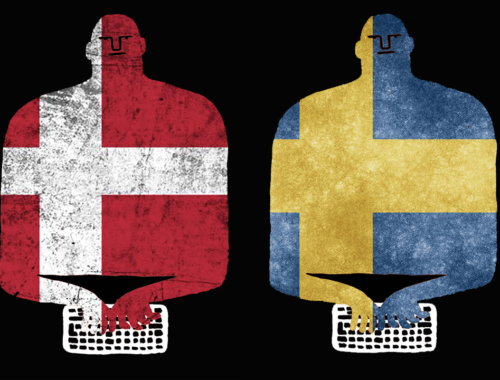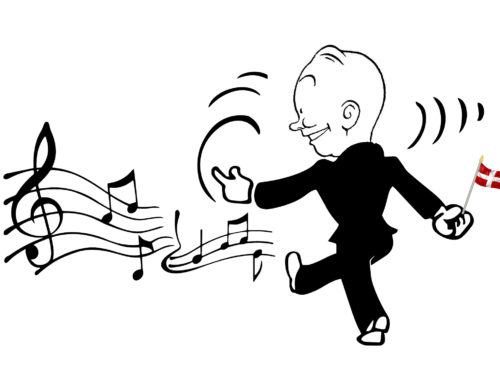I’ve referred to “The Danish Year” before on How to Live in Denmark. It’s a series of events that are simply expected to happen every year in Denmark, even if they aren’t formal holidays. In 2025 I’m going to try to do a podcast every month about aspects of the Danish year, and how they fit into the overall context of where Denmark is coming from, and where it’s going.
I travel a lot around Denmark, giving speeches in various cities and towns, and I usally travel on the on the Danish train network, DSB. Danes love to hate DSB, but I kind of like it. The trains are clean, generally on time, and you even get frequent traveler miles for your trips that you can use to buy ice cream or other snacks. And the trains have big windows that you can look out and see this lovely, flat country roll by.
The name of this podcast is How to Live in Denmark, but Denmark is not a uniform thing. The landscape differs – a few hills in some places, forests in some places, water to cross over – and the government differs. While the Parliament in Copenhagen decides on big issues like defense and immigration, local authorities are in control of things that really matter to everyday life.
Democracy in Denmark: localities have a lot of control
Child care or eldercare or job centers or services for the disabled are different depending on where you live in this little country of 6 million people.
Health care is regional: you might get shorter wait times in hospitals in one region or more varied psychiatric options in another.
And the income taxes are higher in some localities than in others.
If you move house in Denmark, even if you don’t move very far, you may find your paycheck getting bigger or getting smaller.
The reason I bring this up now is that it is local election time in Denmark, and October is when the campaign swings into gear. Danish elections themselves usually planned for June and November, when voters have time and aren’t away on their many Danish vacations.
This helps create high turnout, usually about 70% for local elections, 85% for nationals.
Like almost everything else in Denmark, it’s well-designed.
Election poster hanging is competitive
But it’s now, in October, when the campaign posters begin to go up, always precisely 28 days before the vote.
It’s a derby: this year, on October 25 at precisely noon, the whistle blows, and they’re off, teams of poster hangers. Every party wants to put their posters on the very best lamp posts and bridges and trees and fences.
It’s against the law to take down posters once they’re hung, so there’s a big rush to get your party’s poster up first.
So on that October Saturday you’ll see teams of young people rushing about with ladders, and hardback posters, and zip ties, and measuring sticks, because all posters must be at least one-and-a-half meters below power lines.
There are a lot of young people available to do this because most Danish parties have a youth wing. There are also a lot of young candidates.
You’ll sometimes see the candidates themselves putting up posters with their own face on them.
Danish design not reflected in election posters
Oddly, in a country famous for its design, all Danish election posters are styled pretty much the same. It’s somebody’s face, looking down on you from above like the Teletubby baby, and their name, and the letter and colors that show which party they represent
That’s it. No slogans, no promises. What do they want to do when they get in office? Who knows. Apparently it’s your job to go look that up.
There are currently 13 national parties in Denmark, and a lot more locally. So you generally have to do some background research when you vote in Denmark, because there are so many parties it’s hard to know who you agree with.
Many media outlets offer online questionnaires where you can input your own political beliefs and it will spit out a candidate and party that matches them.
Danish political parties spring up like flowers, then fade
And those parties are constantly changing.
Danish political parties are like spring flowers. They bloom because of one particular issue – like the car tax, there was a whole political party basically dedicated to lowering the car tax – or when a popular politician leaves a main party and takes her followers with her, creating something new.
But then, when that politician retires or becomes unpopular, or when the issue fades in importance, the party goes broke and dies, or merges into some other party.
Big parties have taken on anti-immigrant issues
Sometimes a little parties disappear because big parties take over their signature issue.
Many of the smaller parties that have sprung up have been anti-immigration parties, some might say anti-foreigner.
But those attitudes have been adopted by big, established parties, including left-wing ones like the Social Democrats. The Social Democrats, the party of prime minister Mette Frederiksen, have been part of a colalitioon that has tightened the requirements for permanent residency for years.
People who move to Denmark never really know how long they’re going have to wait, or what they’re going to have to do, in order get the right to build their lives here.
Even for non-Danes with permanent residency, the atmosphere can be icy: the new immigration minister, who is also a Social Democrat, emphasizes that it is the job og newcomers’ to integrate with the Danes, not the other way around.
Foreigners can vote in Danish local elections
Ironically, foreigners can vote in Danish elections, at least in local ones. If you’re an EU citizen, a UK citizen, or a non-EU citizen who has lived in a municipality for at least 4 consecutive years, you can vote just like the Danes.
I recently attended a debate in English in Copenhagen featuring Danish candidates who were going after the foreigner vote, which is about 15% of the voter base in capital, although only a small percentage of those voters actually turn up.
It wasn’t a particularly impressive debate – some of the candidates appeared to be struggling with their English – but the fact that it took place all is ironic, some Danish politicians seeking the foreigner voter while other Danish politicians try to throw foreigners out.
Candidate’s face on a bon-bon wrapper
And foreigners can also run for local office in Denmark. You don’t have to be a Danish citizen, you just have to have lived in the locality for 4 consecutive years.
It’s nice to see so many different types of people participate in Danish democracy at the very local level. Young, old, ethnic Danes, immigrants.
You’ll meet them, too, in shopping centers or train stations, handing out election fliers embossed with their own faces. I remember last election one lady gave out bon-bons with her face on the wrapper, and she won.
You’ll even see some of their faces on election posters out the windows of the trains that ride through Denmark. Giant faces, smiling down on you, hoping for victory.




